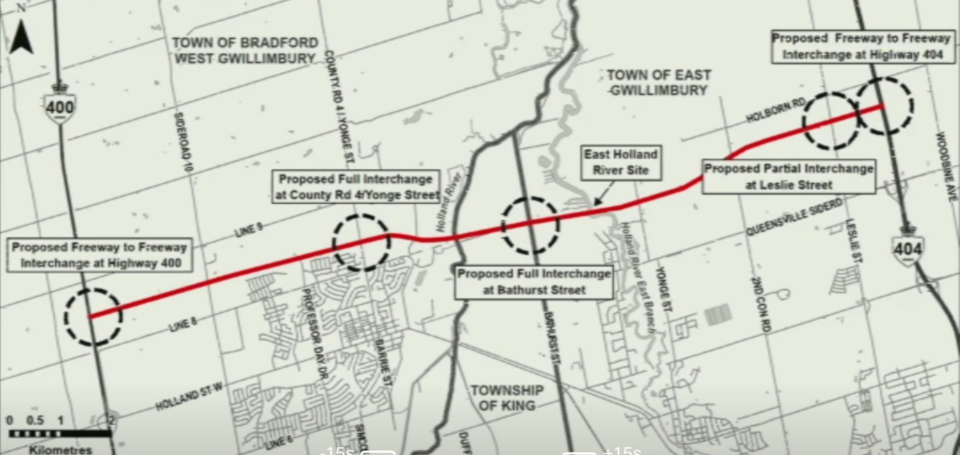Bradford West Gwillimbury council received an update on the Bradford Bypass at its Feb. 7 meeting, but some councillors were left without getting an answer to their biggest question.
Councillors Ben Verkaik and Peter Dykie each pressed representatives from the Ontario Ministry of Transportation (MTO) and AECOM on a timeline for completion of the highway project. Verkaik stressed the need for the town to know when the road will be ready, allowing for internal transportation plans to take shape, while Dykie focused on the need for area property owners to have clarity as to what they can or can’t do with their lands, and when.
But the group presenting – who led the previous public information centre (PIC) last fall – weren’t equipped to answer questions on completion. As engineers conducting an environmental assessment, their expertise lies more within could or should the Bradford Bypass be built, not when it would be built.
“We are anticipated to complete this project in 2023,” explained Wan Chi Ma, senior project manager for the MTO. “Right now, we are still focusing on this phase. Until this phase is completed, I don’t have a definite timeline at this time.”
This phase ends with a completed environmental impact assessment report for the Bradford Bypass, which will be made available for public comment at that time. Also expected to be completed this year is the finalized preliminary design. From there, the consultants insisted, the detailed design process can begin in earnest and a better view of the timeline will be known.
However, while not exact, the presentation to councillors, similar to that of the PIC in November, anticipates traffic moving on the Bradford Bypass by 2031 at the latest, in its initial four-lane configuration.
More than 40 potential routes for the east-west link between Highway 404 and Highway 400 have been considered, with the one being studied by the MTO and AECOM currently being deemed the least impactful. However, there remain impacts. The environmental impact assessment report will consist of 15 environmental impact studies that document the conditions that currently exist along the corridor where the highway is proposed to be constructed.
Coming out of the November PIC, some who took part in the virtual call came away convinced their concerns wouldn’t be taken seriously, particularly in terms of noise and vibration. Councillor Nick Harper was one of the participants in the PIC and was glad to see movement on the side of the provincial government.
The initial results of the noise assessment have identified 16 noise-sensitive areas, Holly Wright, senior environmental planner for AECOM, explained to councillors. Preliminary results presented at the PIC and reiterated during the council meeting suggest noise mitigation might not be necessary, “however, noise investigations are still underway and subject to change,” she said.
Wright was also able to explain how the government is working to lessen the impact on the Holland Marsh through the design of the bypass, in answering a series of questions from Councillor Jonathan Scott on the environmental concerns raised to him by residents.
“We’re continuing to carefully consider all impacts to wetland areas and we’ll work with the environmental agencies, municipalities, and any concerned stakeholders to identify measures to avoid or mitigate any potential impacts in accordance with any regulatory requirements,” Wright said. “It is anticipated that that project will cross the Holland Marsh provincial significant wetland at two points: the Holland River and Holland River East Branch. The crossing locations were chosen because they’re consistent with the ministry’s efforts to minimize impacts to the sensitive wetland area and they are also among the narrowest portions of the Holland Marsh.”
Currently included in the preliminary design for the Bradford Bypass are elevated crossings through the Holland Marsh, spanning over the provincially significant wetland and “providing appropriate navigational clearance.”
Scott referred to the Bradford Bypass as “the infrastructure project nuance forgot,” acknowledging those who wonder why it hasn’t been built yet and those who feel it shouldn’t be built at all.
He stressed to the consultants that any support for the project hinges on it being done right.
“I think we all know our residents, our farmers, our commuters, our downtown business owners and people who really live in the area of town that has the traffic for the entire region going through it right now recognize the need for the highway,” Scott said. “But that doesn’t mean we don’t want it to be done properly with environmental consideration and due diligence undertaken.”
